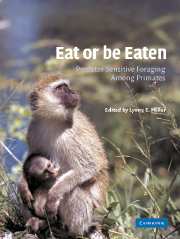Book contents
- Frontmatter
- Contents
- List of contributors
- Preface
- 1 An introduction to predator sensitive foraging
- PART I BIOLOGICAL VARIABLES
- PART II SOCIAL VARIABLES
- 6 The role of group size in predator sensitive foraging decisions for wedge-capped capuchin monkeys (Cebus olivaceus)
- 7 Group size effects on predation sensitive foraging in wild ring-tailed lemurs (Lemur catta)
- 8 Species differences in feeding in Milne Edward's sifakas (Propithecus diadema edwardsi), rufus lemurs (Eulemur fulvus rufus), and red-bellied lemurs (Eulemur rubiventer) in southern Madagascar: Implications for predator avoidance
- 9 Evidence of predator sensitive foraging and traveling in single- and mixed-species tamarin troops
- 10 Predator (in)sensitive foraging in sympatric female vervets (Cercopithecus aethiops) and patas monkeys (Erythrocebus patas): A test of ecological models of group dispersion
- 11 Predation risk and antipredator adaptations in whitefaced sakis, Pithecia pithecia
- PART III ENVIRONMENTAL VARIABLES
- Index
8 - Species differences in feeding in Milne Edward's sifakas (Propithecus diadema edwardsi), rufus lemurs (Eulemur fulvus rufus), and red-bellied lemurs (Eulemur rubiventer) in southern Madagascar: Implications for predator avoidance
Published online by Cambridge University Press: 10 November 2009
- Frontmatter
- Contents
- List of contributors
- Preface
- 1 An introduction to predator sensitive foraging
- PART I BIOLOGICAL VARIABLES
- PART II SOCIAL VARIABLES
- 6 The role of group size in predator sensitive foraging decisions for wedge-capped capuchin monkeys (Cebus olivaceus)
- 7 Group size effects on predation sensitive foraging in wild ring-tailed lemurs (Lemur catta)
- 8 Species differences in feeding in Milne Edward's sifakas (Propithecus diadema edwardsi), rufus lemurs (Eulemur fulvus rufus), and red-bellied lemurs (Eulemur rubiventer) in southern Madagascar: Implications for predator avoidance
- 9 Evidence of predator sensitive foraging and traveling in single- and mixed-species tamarin troops
- 10 Predator (in)sensitive foraging in sympatric female vervets (Cercopithecus aethiops) and patas monkeys (Erythrocebus patas): A test of ecological models of group dispersion
- 11 Predation risk and antipredator adaptations in whitefaced sakis, Pithecia pithecia
- PART III ENVIRONMENTAL VARIABLES
- Index
Summary
Introduction
Despite the difficulty in documenting it, predation pressure has long been acknowledged to play a powerful role in shaping the behavioral ecology of extant primates (Anderson 1986, Cheney and Wrangham 1987, Isbell 1994). Its role as a selection pressure on the lives of prosimian primates, however, has been debated (van Schaik and Kappeler 1996). As research on prosimian social structure in southern and western parts of Madagascar began to flourish in the late 1960s and 1970s, it was believed that predators had little influence on prosimian behavioral ecology (Jolly 1966, Richard 1978). This perspective, however, has been reevaluated with the dramatic increase in research on a wider range of species in a variety of habitats.
It is now clear that a variety of prosimian species exhibit a wide range of antipredatory behaviors. Goodman (1994a,b) has suggested that these behaviors are residual tactics which remain in the repertoire following the recent extinction of a large crowned eagle (Stephanoaetus mahery; but see Csermely 1996). However, recent longterm studies have demonstrated that predation pressure remains a real threat from extant raptors (Goodman et al. 1998, Gould 1996, Sauther 1989, Schwab 1999), mammalian carnivores (Cryptoprocta ferox and Galidia elegans; Overdorff and Strait 1995, Wilson et al. 1989, Wright 1998, Wright and Martin 1995), owls, and boa constrictors (Goodman et al. 1993, Rakotondravony et al. 1998, Wright and Martin 1995).
Very little is known, however, about which behavioral strategies arboreal prosimians implement to avoid predation (but see Macedonia and Pollock 1989, Oda 1998, Sauther 1989, Wright 1998, Wright et al. 1997).
- Type
- Chapter
- Information
- Eat or be EatenPredator Sensitive Foraging Among Primates, pp. 126 - 137Publisher: Cambridge University PressPrint publication year: 2002
- 4
- Cited by



